Last Updated on January 19, 2024 by Greg Gillson
Did you see a brightly-colored red bird, orange bird, or yellow bird in Kentucky and wonder what is was?
This page is for you!
This article shows you photos and identification of some of the most common birds in Kentucky based on color.
The list of birds found in Kentucky includes over 390 species. So, I can’t show you all of them. I’m going to assume that you saw a common bird of this color, but you certainly could have seen something less common, or even rare!
Shape (including the shape of the bill) and size are often more helpful in starting to identify a bird than the color. In fact, most birds in North American can be easily identified with a black-and-white photo!
Many birds are multi-colored, so that it may be hard to pick out a dominant color. Males and females may be colored quite differently. And some color patterns are similar among otherwise dissimilar species.
Nevertheless, I’m going to try to pick out some of the birds that you are most likely to see in backyards or towns. And I’ll show a few others that I get asked about a lot.
The birds with a noticeable amount of red on them in Kentucky covered in this article are:
- Northern Cardinal
- American Robin
- House Finch
- Ruby-throated Hummingbird
- Summer Tanager
- Red-headed Woodpecker
The birds with a noticeable amount of orange on them in Kentucky covered in this article are:
- Eastern Towhee
- Barn Swallow
- Brown Thrasher
- Red-shouldered Hawk
- American Kestrel
- Wood Thrush
- Cooper’s Hawk
- Baltimore Oriole
- Orchard Oriole
The birds with a noticeable amount of yellow on them, including lots of yellow and black birds, in Kentucky covered in this article are:
- American Goldfinch
- Northern Flicker
- Eastern Meadowlark
- Yellow-rumped Warbler
- Common Yellowthroat
- Northern Parula
- Cedar Waxwing
- Great Crested Flycatcher
- Yellow-breasted Chat
- Dickcissel
- Prairie Warbler
- Yellow-throated Warbler
- Yellow-throated Vireo
- Prothonotary Warbler
- Kentucky Warbler
Red birds of Kentucky
Birds get the red, orange, and yellow in their feathers from carotenoids in the fruit, seeds, and plants they eat (source).
These carotenoid colors combine with melanin to form an infinite range of red feathers–pink, rusty, scarlet, violet, red-orange.
The following are red birds that you are most likely to see in Kentucky.
Northern Cardinal
These are one of the most common backyard birds in the eastern United States. Their bright red color and unique head profile makes them instantly identifiable to most people–whether they are bird watchers or not!
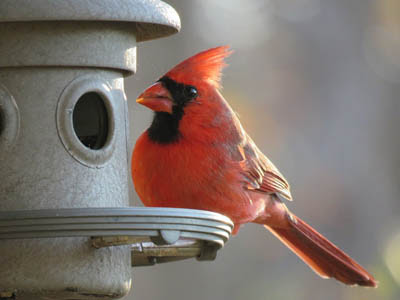 |
| Northern Cardinal. GeorgeB2 from Pixabay. |
Males of these large seed eaters are bright red with a black face and red crest.
Females replace most of the red with brown, The bill is large and orange.
These birds are found in woodlands, stream edges, residential areas.
Northern Cardinals are year-round residents throughout Kentucky.
American Robin
These are familiar lawn birds with red breasts.
 |
| American Robin. Greg Gillson. |
Male American Robins are brownish-gray above with a brick red breast. Females are paler orange below and paler gray above.
They are widespread in open country with scattered deciduous trees, residential areas.
American Robins are year-round residents throughout Kentucky.
House Finch
When people ask about a bird with a red head at their feeder, it is usually this bird.
 |
| Male House Finch. Greg Gillson. |
Males of this dusty brown striped finch have red limited to the head (specifically the forehead and eyebrow), breast (chest), and rump. The red coloration tends toward orangish, and may rarely be yellowish.
Females are streaked, similar to the males but without red. They lack any strong pattern on the face and head.
Note the small round head and curved upper ridge on the bill.
Some people call these red-headed sparrows. Sparrows and finches are similar, but in general, male finches are brighter than the females and tend to hang out more in trees. Sparrow genders are usually quite similar in coloration and tend to feed mostly on the ground.
These birds are common in residential areas, especially at bird feeders. In the West more widespread in arid regions near water.
House Finches are year-round residents throughout Kentucky.
Ruby-throated Hummingbird
These red-throated birds are the only hummingbird nesting in the eastern United States.

Males are dark green above and on the belly. They have a white upper chest. The throat is ruby-red.
Females are green above, white below, including white throat.
These birds are found in woodland edges, residential yards. Readily come to hummingbird feeders.
Ruby-throated Hummingbirds are summer residents throughout Kentucky.
Summer Tanager
These bright red birds are found toward the tops of tall trees in the southern United States.

Males are rose red with fairly heavy bill.
Females are yellowish or mustard-colored, some with a faint reddish wash.
In the East these birds are found in pine-oak woodlands. In the West they prefer tall cottonwood trees.
Summer Tanagers are summer residents throughout Kentucky.
Red-headed Woodpecker
These well-known woodpeckers with red heads have a fitting name.
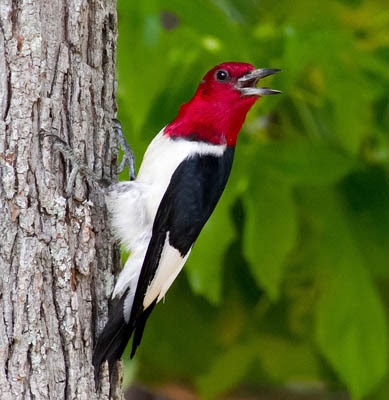 |
| Red-headed Woodpecker. Public domain. |
These birds have the entire head bright deep red. Back and tail black. Underparts white, as are inner secondaries and rump.
They are found in a variety of wooded habitats. They prefer to have oak and beech trees available. Sometimes come to feeders in winter.
Red-headed Woodpeckers are year-round residents throughout most of Kentucky, absent in extreme southeastern Kentucky.
Orange birds of Kentucky
True orange-colored birds are not that common. Many birds that I have here are paler rusty.
The common pattern is an orange body and black or brown wings and tail. Another common pattern is for the orange to be restricted to the under parts.
The following are orange birds that you are most likely to see in Kentucky.
Eastern Towhee
These birds with rusty-orange sides like to hide in dense bushes.
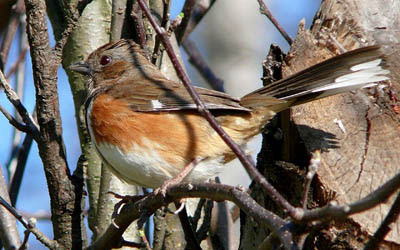 |
| Female Eastern Towhee. Skeeze. Pixabay. |
Males are black above with white wing patch, white tail corners. The sides are rusty. The belly white. Eyes variable: brown, red, orange, white, tending toward whiter southward.
Females are similar, but upper parts brown.
These birds are found in forest understory, dense brush, backyard hedges. Come to feeders.
Eastern Towhees are year-round residents throughout Kentucky.
Barn Swallow
These orange-bellied birds are a familiar sight across North America in summer.
 |
| Barn Swallow. Greg Gillson. |
These birds are purple-blue above with orange under parts and long forked tails. The color of the underparts in winter or on females are often cinnamon or buff-colored, but breeding males can be brighter orange-red.
These birds swoop low over fields and wetlands at lower elevations. They may build their mud nests in rafters on porches, garages, or other out-buildings.
Barn Swallows are summer residents throughout Kentucky.
Brown Thrasher
These are rather large rusty-orange songbirds.
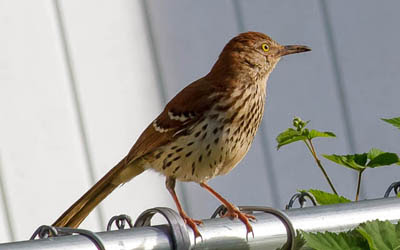 |
| Brown Thrasher. Linda Jones CC0. |
The upper parts of these birds is colored rusty-brown to orange. They show two white wing bars. Under parts are buff with heavy reddish-brown streaking.
These birds live in woodland edges and mature backyard landscaping.
Brown Thrashers are year-round residents throughout most of Kentucky, summer residents only in northeastern Kentucky.
Red-shouldered Hawk
Okay, the shoulders are reddish. But the rusty-orange breast and wing linings are barred red too.
 |
| Red-shouldered Hawk. Greg Gillson. |
The upper parts are barred black and white. The tail is banded black and white. In adults the breast is barred orange.
Immature birds are streaked with brown on the breast.
These birds like woodland edges, residential edges, riparian groves.
Red-shouldered Hawks are year-round residents throughout Kentucky.
American Kestrel
These are the familiar small rusty-orange falcons sitting on power lines on the edge of the highway, or hunting and hovering over the median strip.
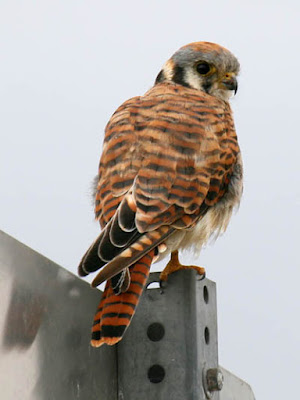 |
| Female American Kestrel. Greg Gillson. |
Females are rusty orange barred with black on their back wings and tail. The under parts are buff with black spots. The head shows two facial stripes.
Males have blue-gray backs and rufous tail is unmarked except for black tail band.
These birds are found in open country, farms, pastures with perches.
American Kestrels are year-round residents throughout Kentucky.
Wood Thrush
These spotted birds with the orange-brown upper parts tend to hide in understory trees and on the forest floor.
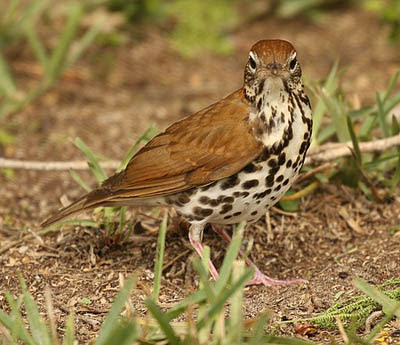 |
| Wood Thrush. Tony Castro. CC BY-SA 4.0 |
These birds are reddish brown on the upper parts, especially rusty orange on the crown and upper back. White eye ring. Large heavy black spots on the under parts.
They live in deciduous and mixed woods. Spend much time on the ground, shuffling through the leaf litter.
Wood Thrushes are summer residents throughout Kentucky.
Cooper’s Hawk
These crow-sized hawks with reddish orange bars on the under parts may show up in fall or winter to hunt birds at your feeder. Oh no!
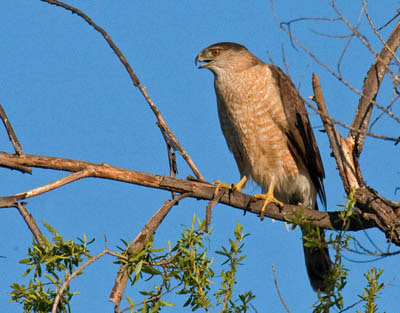 |
| Cooper’s Hawk. Greg Gillson. |
Adults with long gray and black banded tail. Dark gray above and cap on head. Under parts barred with rusty orange.
Immatures similar, brownish, streaked with brown on under parts.
Found in forests and woodlands, residential shade trees.
Cooper’s Hawks are year-round residents throughout Kentucky.
Baltimore Oriole
These bright orange and black birds are fairly common breeders in wooded areas in the East.
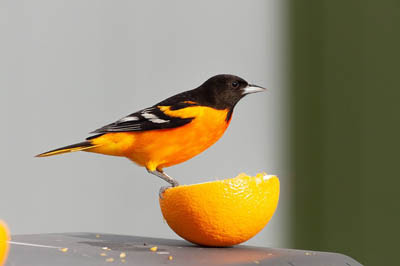 |
| Baltimore Oriole. Michael McGough. Pixabay. |
Males are have a black hood and back. Wings black with white patches. Tail black with orange sides to the base. Bright orange under parts.
Females are similar to males, but more olive above, less black. Immature birds for their first year or more are olive above orangish-yellow on the breast, fading to yellow on the belly. Two white wing bars.
These birds are common in deciduous woods, shade trees.
Baltimore Orioles are summer residents throughout Kentucky.
Orchard Oriole
Males of these orioles are darker rustier-orange than most other orioles in the United States.
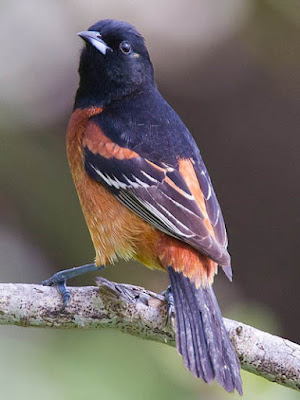 |
| Orchard Oriole. Dan Pancamo. Flikr. CC BY-SA 2.0 |
Males have a black hood and back, black wings and tail. The under parts are rusty-orange or even chestnut-brown.
Females are greenish above, lemon yellow below. They have 2 thin white wing bars. The bill is thinner than many other orioles.
They are found in orchards and residential shade trees.
Orchard Orioles are summer residents throughout Kentucky.
Yellow birds of Kentucky
Yellow is a common bird color! Often it is mixed with black and white plumage in birds.
Many birds with darker upper parts have yellow breast or belly.
The following are yellow birds you are most likely to see in Kentucky.
American Goldfinch
These small little birds are bright yellow and black.
 |
| American Goldfinch. Greg Gillson. |
Males are bright lemon yellow with black and white wings and tail, black cap. White under tail coverts. Pink bill.
Females are duller yellow below and brownish above. Lack black cap.
Winter birds are pale brown or gray, a touch of yellow on the throat of males.
These are birds of open country, fields with saplings, clear cuts, residential areas. They avoid dense forests, mountains, deserts. They visit feeders.
American Goldfinches are year-round residents throughout Kentucky.
Northern Flicker
These woodpeckers spend much time eating ants on the ground.
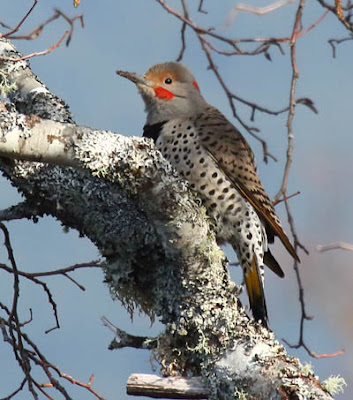 |
| Northern Flicker. Greg Gillson. |
These birds are larger than robins with brown and black barred upper parts. The underparts are pink with round black spots. There is a black crescent across the chest. When they fly away from you they reveal a large white rump.
Western birds have salmon-red under wings and under tail. Those in the East are colored yellow. The male face differs between the two populations–black whisker on the eastern birds, red whisker on western birds. Intergrades from overlap on Great Plains common. These may show male facial characteristics of both populations, or yellow-orange flight feathers.
These birds live in open woods with bare ground for foraging, residential yards.
Northern Flickers year-round residents throughout Kentucky.
Eastern Meadowlark
These pale brown birds with the brilliant yellow breasts are home on the ground in prairies. They sing from perches on isolated trees, power poles, fence posts.
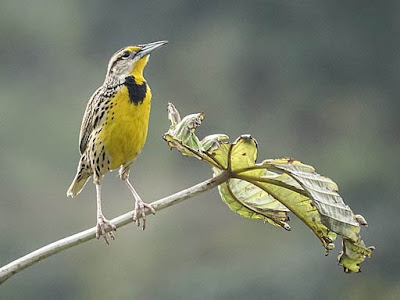 |
|
Eastern Meadowlark
Photo by Mike’s Birds from Riverside, CA, US [CC BY-SA 2.0]
|
The upper parts are streaked black, white, brown, so they blend into the dried grass where they live. The under parts are bright yellow with a black necklace across the chest. Very similar to Western Meadowlark, best told apart by spring song.
These birds live in prairies and extensive pasture lands.
Eastern Meadowlarks are year-round residents throughout Kentucky.
Yellow-rumped Warbler
These are abundant warblers across North America. Affectionately called “butter butts” by many birders, because of their bright yellow rumps that flash in flight.
 |
| Breeding Myrtle Yellow-rumped Warbler. Greg Gillson. |
Western form (Audubon’s) with bright yellow throat and yellow rump. Large white wing patch.
Northern and Eastern form (Myrtle) with white throat, yellow rump, and two white wing bars.
Winter birds are dull gray brown, with bright yellow rump. Throat may be cream colored or white. Often difficult to tell the two forms apart in winter.
 |
| Winter Yellow-rumped Warbler. Greg Gillson. |
Breed in mountain or boreal conifers. Widespread in migration. Winter in low river bottoms, open weedy deciduous areas. Rarely come to feeders in winter.
Yellow-rumped Warblers are winter visitors throughout Kentucky.
Common Yellowthroat
These buttery yellow birds are abundant in the marsh vegetation.
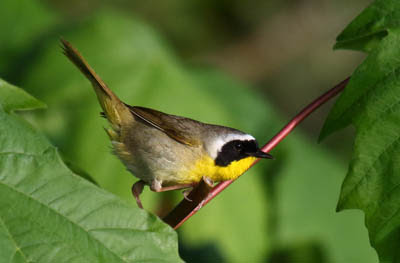 |
| Male Common Yellowthroat. Greg Gillson. |
These skulkers have bright yellow throats and yellow undertail coverts. Males have a black domino mask edged broadly in white, which females lack. Upperparts are dull olive-green.
Immature males in fall show a shadowed black mask.
Found in damp situations and heavy deciduous brambles following clear cuts.
Common Yellowthroats are summer residents throughout Kentucky.
Northern Parula
This is a handsome blue and yellow warbler.

Males are blue on the hood and shoulders. Back green. Yellow throat and breast with a dark red spot mid-chest. Broken white eye ring. Two wide white wing bars.
Females are similar, but paler.
They are found along streams and in swampy forests with willows, maples, birches, hemlocks and other trees.
Northern Parulas are summer residents throughout Kentucky.
Cedar Waxwing
These crested birds with yellow band on the end of the tail are often found in flocks. They eat flying insects in summer, fruit and berries the rest of the year.
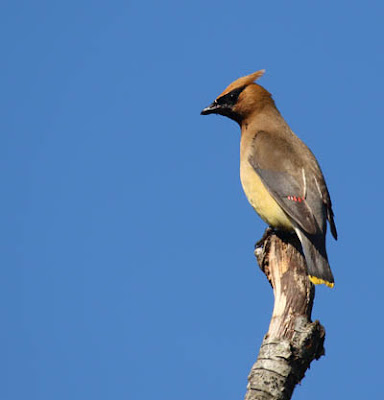 |
| Cedar Waxwing. Greg Gillson. |
These birds are fawn-brown above, with dark gray wings and tail. They have a black mask and wispy crest. The belly is yellow. The wings have waxy red drops on the end of the tertials. The end of the tail has a brilliant yellow tail band.
They are found in open habitats with berries, including juniper woodlands and towns in winter.
Cedar Waxwings are year-round residents throughout Kentucky.
Great Crested Flycatcher
These flycatchers have long tails and big heads with big bill and bright yellow belly.
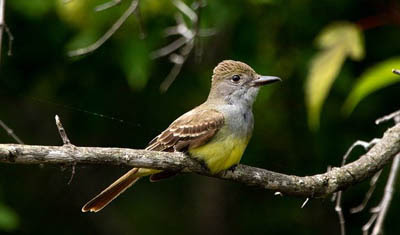 |
| Great Crested Flycatcher. Simard Francois. Pixabay. |
These birds are gray on the face and breast, brownish on rest of upper parts. Bright lemon yellow belly. The under side of the tail and some feathers of the wing are cinnamon colored.
These birds stay in the canopy of open woods.
Great Crested Flycatchers are summer residents throughout Kentucky.
Yellow-breasted Chat
These unique larger yellow birds may sing day and night, and include whistles and crow-like cawing, often given in a display flight.
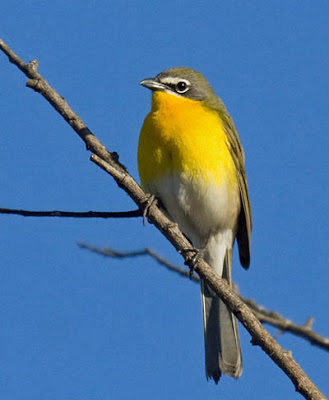 |
| Yellow-breasted Chat. Greg Gillson. |
These birds are greenish above with bright yellow breast and white belly. They have a dark mask bordered with white.
These birds live in tangles and wet woods.
Yellow-breasted Chats are summer residents throughout Kentucky.
Dickcissel
These yellow birds often flock together in weedy roadside edges.
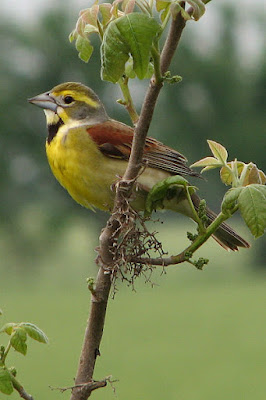 |
| Dickcissel. RebelAT. CC By-SA 3.0 |
These are gray birds with yellow breast and eyebrow.
Males have a black band across the lower throat. They have a large chestnut patch on the shoulder.
Females paler, lack black chest band.
They are found in prairie grasslands and weedy patches.
Dickcissels are summer residents throughout most of Kentucky.
Prairie Warbler
These birds with the yellow breasts and odd black line under the eyes are a resident of mangrove swamps.
 |
| Prairie Warbler. Public domain. |
Males are olive-green on the crown and back with chestnut streaks. Greenish-gray wings have pale wing bars. Yellow face and under parts. Yellow eyebrow, patch under eye. Black line through eye and below yellow under eye patch. Black streaks on sides.
Females are similar but facial pattern fainter, replaces black with green.
They are found in open scrubby woods, mangrove swamps.
Prairie Warblers are summer residents throughout most of Kentucky, absent in parts of far western Kentucky.
Yellow-throated Warbler
These birds with the bright yellow throats creep along the branches high in trees.
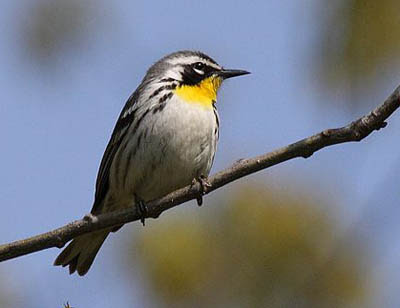 |
| Yellow-throated Warbler. Dominic Sherony. CC 2.0 |
These are rather gray warblers with bright yellow throat and upper breast. Black crown and face mask with white patch behind. White eyebrow. Two broad white wing bars. Black streaks on white breast and belly.
They like pine-oak woodlands, sycamores, cypress.
Yellow-throated Warblers are summer residents throughout Kentucky.
Yellow-throated Vireo
Vireos are slow moving small birds that sing throughout the day. These yellow-headed vireos are one of the most colorful of their clan.
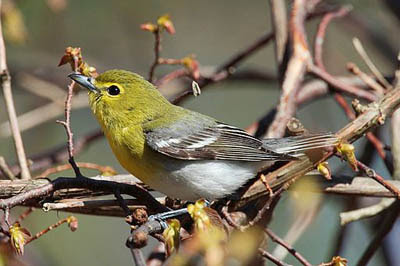 |
| Yellow-throated Vireo. MDF. CC BY-SA 3.0 |
These birds are blue-gray above, white below. Two white wing bars. Their head is olive yellow with yellow spectacles around the eye, and bright yellow throat.
These birds like large tracts of unbroken deciduous or mixed woodlands. Interestingly, however, they are often found on forest edges.
Yellow-throated Vireos are summer residents throughout Kentucky.
Prothonotary Warbler
These bright yellow birds are found in southeastern swamps.
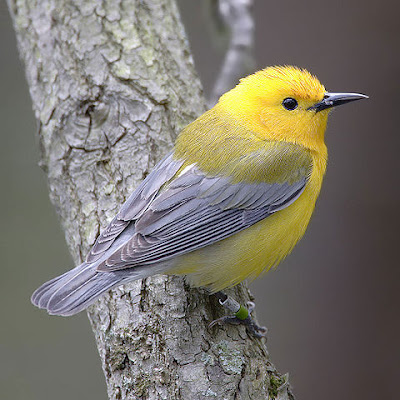 |
| Prothonotary Warbler. MDF. CC BY-SA 3.0 |
These birds are bright yellow with green back, gray wings and tail. The beady black eye stands out in the middle of the yellow face.
These birds stay low in the understory in swamps and bottomland forests, near or over water.
Prothonotary Warblers are summer residents throughout most of Kentucky.
Kentucky Warbler
These birds with the yellow eyebrow and underparts are usually found low to the ground.
 |
| Kentucky Warbler. Tony Castro. CC-BY-SA 4.0 |
These birds are green above and yellow below.
Males have a black cap and mask below the eye, forming a bright yellow eyebrow.
Females are similar, but the black on the head is not as dark.
They are found in dense understory in hardwood forests, often near streams.
Kentucky Warblers are summer residents throughout Kentucky.
Wrapping Up
The red, orange and yellow birds of Kentucky certainly steal the show but there are other dazzling birds out there. Here are my pick of the colorful rest:
Eastern Bluebird: These sky-blue wonders with orange chests add a cheerful spark to open fields and woodlands. Their melodious songs complete the charming package.
Indigo Bunting: The male’s vibrant blue body and black bib create a stunning contrast, especially in sunlight. The female is a more subtle but equally beautiful mix of brown and blue.
Blue-gray Gnatcatcher: These tiny marvels with long tails and distinctive black masks flit through treetops, flashing their blue-gray plumage and uttering high-pitched calls.
Belted Kingfisher: This turquoise-backed bird with an orange breast perches on branches overlooking water, diving headfirst to catch fish. Their loud rattle call is unmistakable.
Yellow-throated Warbler: This energetic little bird with a bright yellow throat and olive-green upperparts adds a sunshine spark to gardens and woodlands throughout the year.
Pine Siskin: These winter visitors from the north showcase a vibrant blend of yellow, brown, and streaked patterns, adding a splash of color to snowy landscapes.
Ovenbird: This ground-dwelling warbler has an olive-green body with a distinctive orange crown and white spectacles around its eyes. Look for them hopping among leaf litter and singing their flute-like song.

Frequently Asked Questions
Which bright red bird is the state bird of Kentucky?
The bright red bird that is the state bird of Kentucky is the Northern Cardinal. These striking birds, with their vibrant red plumage in males and brown with red accents in females, are a familiar sight and symbol of the state. Their clear, whistling songs add to their charm and make them a joy to encounter in backyards, fields, and woodlands.
So, next time you see a beautiful red bird in Kentucky, remember that you’re looking at the official avian ambassador of the state!
Where can I see the Orchard Oriole in Kentucky?
The Orchard Oriole, with its vibrant orange and black plumage, is a beautiful songbird found in several areas of Kentucky. Here are some tips on where you’re most likely to encounter these feathered friends:
Orchard Orioles prefer open woodlands with scattered trees, often near water sources like rivers, streams, or ponds. Look for them in orchards, parks, wooded edges of fields, and areas with scattered deciduous trees like cottonwoods, maples, and elms but avoid dense forests and evergreen groves.
Orchard Orioles are more common in the western and central parts of Kentucky, though they can occasionally be found in other areas, especially during migration. Some promising areas include Land Between the Lakes National Recreation Area, Green River Lake State Park, Big Bone Lick State Park, and Mammoth Cave National Park.
How did the Kentucky Warbler get its name?
The Kentucky Warbler’s name has a straightforward yet interesting origin, reflecting a confluence of location and appearance:
Location: The Kentucky Warbler was first discovered and collected by the pioneering Scottish naturalist Alexander Wilson in 1811, while he was exploring Kentucky. This was significant because the bird was new to science at the time, and the location of its discovery played a crucial role in naming it.
Appearance: The Kentucky Warbler’s olive-green upperparts and bright yellow underparts are its most distinctive features. This color combination resonated with Wilson, who likely found it reminiscent of the lush green forests and bright sunlight characteristic of Kentucky in the spring and summer months.
Therefore, the name “Kentucky Warbler” serves as a tribute to both the location of its discovery and the bird’s striking appearance. It’s a name that aptly captures the essence of this beautiful songbird and its association with the rich natural beauty of Kentucky.
Related:
See photos and learn about the most common backyard birds in Kentucky, regardless of color.
See photos and learn what to feed winter birds in Kentucky.
Learn about the Birds at Your Feeder in Kentucky.
Here’s a quick tutorial of how I would teach you to identify birds: 7 Steps to Identify Birds!










